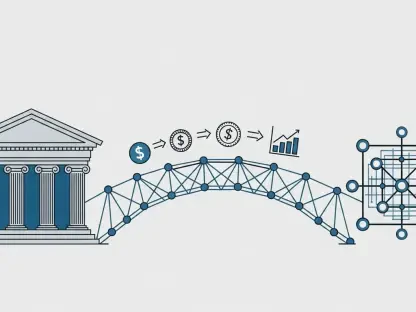Imagine a Europe where payments are instantaneous, secure, and accessible to everyone, whether online, in-store, or person-to-person, without the need for physical cash, transforming the way financial transactions are conducted across the continent. This vision is at the heart of the digital euro initiative, a groundbreaking project spearheaded by the European Central Bank (ECB) to modernize the continent’s financial landscape. As digital currencies gain traction globally, the digital euro stands as a potential game-changer, promising to complement traditional money while enhancing accessibility and security for millions of citizens.
Core Features and Technological Innovations
Mobile App as the Gateway
At the forefront of this ambitious project is the development of a mobile application, a critical interface for users to interact with the digital euro. Italian fintech giants Almaviva and Fabrick, under a €153 million contract, are tasked with crafting this app to enable seamless transactions across various platforms. Their focus spans payments in physical stores, e-commerce, and direct transfers between individuals, ensuring a versatile tool for everyday financial needs.
The technical foundation of this app relies on advanced software development kits (SDKs) and application programming interfaces (APIs). These components are designed to integrate smoothly with existing payment service providers across Europe, allowing for a cohesive ecosystem where traditional and digital systems coexist. This integration is pivotal, as it minimizes disruption while expanding the reach of digital payments to diverse user groups.
Infrastructure and Enhanced Functionalities
Beyond the app, Almaviva and Fabrick are building robust supporting infrastructure to underpin the digital euro’s operations. This includes system integration to ensure compatibility with current financial networks and open finance capabilities to foster innovation. Such infrastructure aims to create a scalable platform capable of handling high transaction volumes with reliability.
Additional functionalities are also under exploration, including offline payment options for areas with limited connectivity and programmable features for automated transactions. These elements are being tested in collaboration with other specialized partners, highlighting a commitment to addressing real-world challenges. The emphasis on such features underscores the goal of making the digital euro a practical and inclusive solution for all Europeans.
Collaborative Ecosystem Driving Development
Diverse Partnerships for a Holistic Approach
The ECB has strategically assembled a network of partners to tackle the multifaceted challenges of implementing a digital currency. Firms like Feedzai are enhancing fraud detection and risk management, while Giesecke+Devrient focuses on offline payment solutions to ensure accessibility in remote regions. EquensWorldline contributes to secure data exchange, a critical aspect of maintaining user trust.
Other collaborators, such as Sapient, provide alias look-up services to simplify transactions, while Fluency tests advanced functionalities like offline capabilities through its Aureum platform. Diebold Nixdorf plays a key role in integrating payment processing with existing middleware, ensuring smooth operations. This diversity of expertise forms a comprehensive framework that addresses every layer of the digital euro ecosystem.
Strength in Strategic Alliances
The collaborative approach adopted by the ECB is a cornerstone of the project’s potential success. By engaging partners with specialized skills, the initiative covers critical areas such as user experience, security protocols, and technical integration. This strategy mitigates risks associated with such a complex rollout, fostering confidence in the system’s robustness.
Moreover, these alliances reflect a shared vision of innovation balanced with caution. Each partner’s contribution is tailored to specific needs, ensuring that no aspect of the digital euro—from backend infrastructure to end-user interaction—is overlooked. This meticulous coordination is essential for creating a currency that can stand up to the demands of a diverse and dynamic European market.
Current Progress and Implementation Strategy
Phased Rollout for Stability
The digital euro project follows a structured, phased approach to development, prioritizing stability and user readiness. The initial phase, spanning from now to 2027, focuses on rolling out key use cases to test functionality in real-world scenarios. Subsequent stages will refine these implementations, ensuring operational reliability before any potential launch.
Since its early stages, the initiative has made significant strides, with ongoing efforts centered on building and testing core components. The ECB maintains a deliberate pace, emphasizing thorough evaluation over hasty deployment. This cautious strategy reflects an understanding of the high stakes involved in introducing a digital currency on such a large scale.
Milestones and Ongoing Efforts
Current progress includes the active development of both the mobile app and its supporting systems, with regular assessments to address emerging challenges. Partnerships continue to evolve, incorporating feedback from testing phases to enhance features like security and offline access. This iterative process is designed to build a resilient platform capable of meeting diverse user needs.
The ECB’s commitment to transparency is evident in its updates on the project’s status, ensuring stakeholders remain informed about advancements and hurdles. While a final decision on issuance is pending, the focus remains on creating a digital euro that aligns with European financial goals. This methodical approach aims to balance innovation with the practicalities of widespread adoption.
Potential Impact and Real-World Applications
Transforming Everyday Transactions
Envisioned as a complement to physical cash, the digital euro promises to streamline payments across multiple channels. Whether shopping in a local store, purchasing online, or sending money to a friend, users could benefit from a unified, secure system. This versatility positions the digital euro as a tool for simplifying financial interactions in an increasingly digital world.
The potential to enhance convenience is particularly significant for cross-border transactions within Europe. By reducing friction in payments, the digital euro could foster greater economic integration among member states. Such applications highlight its role as a catalyst for modernizing how money moves in daily life.
Broader Implications for Inclusion and Systems
One of the most compelling aspects of this initiative is its capacity to advance financial inclusion. By providing a digital payment option accessible via mobile devices, the digital euro could reach underserved populations lacking traditional banking services. This inclusivity aligns with broader goals of equitable access to financial tools.
Additionally, the introduction of a digital currency backed by the Eurosystem could reshape the European financial landscape. It offers an alternative to private digital currencies, ensuring public trust through central bank oversight. The ripple effects might influence everything from monetary policy to consumer behavior, marking a significant evolution in payment systems.
Challenges on the Horizon
Technical and Integration Complexities
Despite its promise, the digital euro faces substantial technical hurdles in its development. Integrating with existing financial infrastructures poses a significant challenge, requiring meticulous alignment to avoid disruptions. Ensuring compatibility across diverse systems and platforms remains a priority for developers.
Security concerns also loom large, as a digital currency must withstand cyber threats and maintain user confidence. The complexity of creating a system that is both innovative and robust cannot be understated. Ongoing efforts focus on rigorous testing to identify and address vulnerabilities before they become critical issues.
Regulatory and Public Acceptance Barriers
Navigating the regulatory landscape presents another layer of difficulty, as the digital euro must comply with stringent European financial laws. Crafting policies that support innovation while protecting consumers is a delicate balance. Harmonizing regulations across member states adds further intricacy to the process.
Public acceptance is equally vital, as widespread adoption hinges on trust and ease of use. Educating citizens about the benefits and functionalities of a digital currency will be crucial. The ECB and its partners are actively working to address these concerns through transparent communication and user-centric design principles.
Looking Ahead: The Path Forward
Reflecting on the journey of the digital euro, the collaborative efforts and phased development stand as testaments to a thoughtful approach in reshaping European payments. The strategic partnerships with firms like Almaviva, Fabrick, and others provide a strong foundation, ensuring that diverse aspects of the digital currency are meticulously addressed. The focus on robust infrastructure and user accessibility marks significant progress in the initiative’s timeline.
Moving forward, the next steps should prioritize continued testing and refinement of core functionalities, particularly offline capabilities and security measures. Engaging with stakeholders to build public trust and understanding will be essential for eventual adoption. Exploring scalable models for cross-border integration could further solidify the digital euro’s role in unifying European financial systems.
Ultimately, the focus must remain on striking a balance between technological advancement and practical implementation. Addressing regulatory challenges through proactive dialogue with policymakers can pave the way for smoother deployment. As the project evolves, maintaining this equilibrium will be key to realizing a digital currency that truly transforms the way Europeans interact with money.









